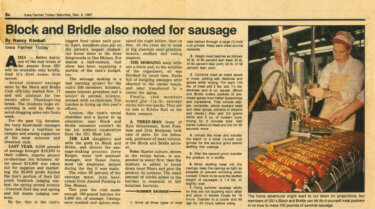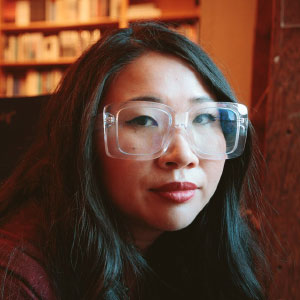Minneapolis native Susan Weber is intimately connected with her food and where it comes from. One of Weber’s strongest childhood memories is visiting her paternal grandfather’s farm, where he grew corn and soybeans and also ran a side business as a butcher. Every spring and fall, their extended family had a unique reunion: “We got together and worked with meat,” Weber said. “I’ve had my hands in meat since I was a little kid.”
During these biannual visits, the extended family of twelve — her father and two uncles and all their spouses and kids — gathered at their patriarch’s Iowa farm. Each time, her grandfather, with help from his three sons, harvested the animals outside and portioned them, enough so that each of the four family units got a quarter of beef and half a hog. The kids helped by trimming the fat. “I started using a knife probably when I was about six,” Weber said. It was cold enough that the cut meat could be left outside on her grandparents’ enclosed porch to freeze overnight, without fear of critters.

Weber and her younger brother and cousins also helped put pork in the grinder for sausage, and she remembers vividly how her jolly grandfather, whose ancestors hailed from Germany, made the sausage that would feed their extended family for the next six months: “He would take the ground pork and spread it out all over the kitchen table, pressed out as thin as he could. Then he’d sprinkle on salt and pepper and sage until it was covered — literally covered.”
A sausage artisan, her grandfather never measured the ingredients. After he added the spices, he folded them into the meat and kneaded the mixture right on the kitchen table until it looked about even. “And then he would take like a nickel-sized piece or so and fry it right there on the spot.” He tasted the cooked sausage to make sure the seasoning was right. The nickel-sized piece got bigger as the grandkids got older, so we all got a taste.”
After college, Weber worked at a meat production facility in quality control. She had to measure the fat content in meat used to make hot dogs, to ensure the final products were uniform. It was a more precise approach than her grandfather’s. But all these years later, Weber found herself still making sausages — a kind of serendipity. Subsequently, she moved to a grain processing company before landing at Hormel Foods, where she started as an analytical clerk in the cost accounting department.
From there, Weber quickly moved into the newly created role of meat-quality technician, collecting data on the pH and color of boneless pork loins. “I had a spectrophotometer, but not like any that I’d seen before. You held this instrument and hit a button, and it looked like it was taking a picture but it actually measured the color of the raw meat. And then a pH meter that you stuck the glass tip in the meat, and it measured the pH.” Weber had been raised to appreciate the art of meat processing, and at Hormel Foods, she learned to love the science as well.
For the last 21 years, Weber has worked in the Hormel Foods research and development chemistry lab to ensure the accuracy of nutritional labels, using specialized tests and equipment to quantify the protein, fat, sodium and other such components of Hormel Foods products. Here, in one of the most sophisticated food science labs in the business, Weber has had the opportunity to learn and master many new technologies.
To test fat content, for example, a sample is placed in the instrument along with ether, which is used to extract the fat. To measure protein levels, a different instrument incinerates the sample and captures the released nitrogen gas, which is then used to calculate protein content. “One of those instruments costs twice as much as my house,” Weber said. The lab also contains a few different types of spectrophotometers and benchtop pH meter, a mass spectrometer to measure mineral content, chromatography equipment and more. The process she’s currently learning is how to measure fiber levels. Weber clearly enjoys being able to continuously learn and takes pride in her work. “The art and science are coming together,” she said.
Weber’s pride in her work carries over even after she leaves the lab. When Weber goes to the grocery store, sometimes sporting a SPAM® brand shirt, and sees a new Hormel Foods product on the shelf, she’ll announce it to her fellow shoppers. “I will tell whoever’s in that aisle with me: ‘Check this out. This is really good.’”
Evolving Traditions and Community
In addition to informing her career in food science, Weber’s childhood experiences are deeply felt in her personal life too. She remains close with her parents, though there’s no longer anything quite like the large family gatherings on her grandparents’ farm. During her last visit to see her parents, Weber’s father recalled the time he tried to keep that tradition with her mother’s side of the family, shortly after her grandfather’s death. “What I remember is my uncle, my mom’s brother, just being aghast that my brother and I were using knives at our tender age. I’m sure he was thinking he was never gonna let his girls do that.” Ironically, one of those cousins married into a butcher’s family, so she’s revived the tradition in her way.
Each family member can keep a small part of those bygone days with them, even as their lives and communities evolve. For Weber’s part, she still makes her own fresh sausages with her grandfather’s recipe. These days, rather than butchering and grinding her own meat, she buys ground pork from a grocery store. She spreads it out on plastic wrap and sprinkles on generous amounts of salt, pepper and sage. “I put a little nutmeg on it to make it my own,” she adds, but never sugar, common in many commercial sausages. “If I intend to use it for pizza, I put a little garlic in as well. But for breakfast sausage, just those three or four ingredients are all you need.”
Recently, she used her homemade sausage to make biscuits and gravy. She shares her food creations with her husband — a former farmer — her parents, and friends and neighbors. Reflecting on her life, she said, “I wouldn’t have known how much I enjoyed working with food if not for those early childhood experiences.”
